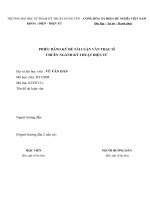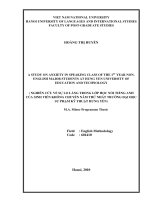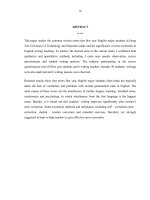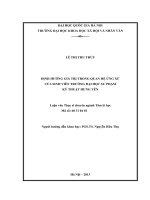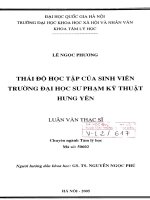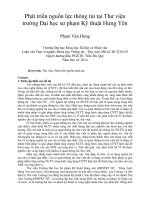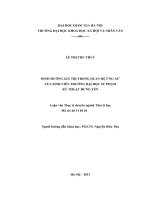ác lỗi viết tiếng Anh sinh viên chuyên ngành tiếng Anh trường Đại học Sư phạm Kỹ thuật Hưng Yên hay mắc phải và ý nghĩa của việc chữa lỗi trong dạy viết
Bạn đang xem bản rút gọn của tài liệu. Xem và tải ngay bản đầy đủ của tài liệu tại đây (2.05 MB, 56 trang )
iii
ABSTRACT
*****
This paper studies the common written errors that first year English major students in Hung
Yen University of Technology and Education make and the significance of error correction in
English writing teaching. To achieve the desired aims of the current study, I combined both
qualitative and quantitative methods, including 3 main ones namely observation, survey
questionnaire and student writing analysis. The subjects participating in the survey
questionnaire were 60 first year students and 6 writing teachers. Besides 30 students’ writings
were also analyzed and 6 writing lessons were observed.
Research results show that errors first year English major students often make are basically
dueto the lack of vocabulary and problems with normal grammatical rules in English. The
main causes of these errors are the interference of mother tongue, teaching- included cause,
carelessness and psychology, in which interference from the first language is the biggest
cause. Besides, it is found out that students’ writing improves significantly after teacher’s
error correction. Some correction methods and techniques, including self – correction, peer –
correction, student – teacher correction and remedial exercises, therefore, are strongly
suggested in hope to help teachers to give effective error correction.
iv
TABLE OF CONTENT
DECLARATION i
ACKNOWLEDGEMENTS ii
ABSTRACT iii
TABLE OF CONTENT iv
LIST OF FIGURES AND TABLES vii
LIST OF ABBREVIATIONS viii
PART A . INTRODUCTION 1
1. Rational of the study 1
2. Aims of the study 1
3. Scope of the study 2
4. Methods of the study 2
4.1. Survey questionnaire 2
4.2. Writing analysis 2
4.3. Observation 2
5. Design of the study 3
PART B : DEVELOPMENT 4
CHAPTER 1 : LITERATURE REVIEW 4
1. 1.Writing 4
1.2. Definition of error 5
1.3. Distinction between errors and mistakes 5
1.4. Sources of errors 6
1.5. Error analysis 8
1. 6. Error correction and significance of error correction 8
CHAPTER II : METHODS OF THE STUDY 11
2.1. Participants of the study 11
2.1.1. Students 11
2.1.2. Teachers 11
2. 2. Data collection instruments. 11
2.2.1. Survey questionnaire 11
2.2.1.1 Reasons for choosing survey questionnaire 11
v
2.2.1.2. Description of survey questionnaires 12
a. Survey questionnaire for students 12
b. Survey questionnaire for teachers 12
2.2.2. Student writing analysis 13
2.2.2.1. Reasons for choosing student writing analysis 13
2.2.2.2. Description of student writing analysis 13
2.2.3. Observation. 13
2.3. Procedure of data collection 13
CHAPTER III : RESULT AND DISCUSSION 15
3. 1. Common errors made by first year English major students in UTEHY based on data
analysis and discussion. 15
3.1.1. Data analysis from questionnaires and observation. 15
3.1.1.1. Students’ attitude towards their errors 15
3.1.1.2. Teacher’s attitude towards students’ errors 17
3.1.2 Data analysis from student writing 19
3.1.3. Discusion 23
3.2.Students’ improvement in writing proficiency as a result of teacher’s error correction 24
3.2.1. Data analysis from questionnaires and observation. 24
3.2.1.1. Students’ attitude towards their improvement in writing proficiency. 24
3.2.1.2. Teacher’s attitude towards their improvement in writing proficiency. 26
3.2.2 Data analysis from student writing analysis 28
3.2.3. Discusion 29
3.3. Some implications for writing teachers 29
3.3.1 Methods to give feedback 30
3.3.1.1. Use error code 30
3.3.1.2. How much and when to correct errors 32
3.3.1.3. Integrate positive and negative, direct and indirect feedback 32
3.3.2. Techniques for error correction 33
3.3.3. Self – correction 34
3.3.4. Peer- correction 34
3.3.5. Student – teacher correction 35
vi
PART C. CONCLUSION 37
1. Summary of the study 37
2. The limitation of the study 38
3. Suggestion for further study 38
REFERENCES: 39
APPENDIXES I
APPENDIX 1 I
APPENDIX 2 IV
APPENDIX 3 VI
APPENDIX 4 VI
vii
LIST OF FIGURES AND TABLES
Page
Figure 3.1. Students’ assessment on difficulty of writing skill
Figure 3.2. Students’ opinion on importance of writing skill
Table 3.1. Student’s opinion on frequencies and quantity or errors
Figure 3.3 Students’ opinion on the causes of errors
Table 3.2. Teachers’ opinion on the importance and difficulty of writing skill
Figure 3.4. Teachers’ opinion on frequencies of errors
Figure 3.5. Teachers’ opinion on quantity of student error
Figure 3.6. Teachers’ opinion on causes of student errors
Table 3.3. Collected data about errors in students’ free writings
Table 3.4. Collected data about errors in students’ final writing tests
Table 3.5. Comparative data about errors made by students
Table 3.6. Types of common errors in writings of the first year English major
students at UTEHY
Figure 3.7.Students’ assessment on the importance of teacher’s error correction
Figure 3.8. Students’ opinion on how teachers correct errors
Figure 3.9. Students’ opinion on how much teachers correct errors
Table 3.7. Students’ assessment on frequencies of error correction techniques
Table 3.8. Students’ assessment on effectiveness of error correction techniques
Figure 3.10.Teacher’s assessment on the importance of teacher’s error correction.
Figure 3.11. The way teacher correct student’s errors
Figure3.12. Teacher’s assessment on the frequencies of using correction
Figure 3.13. Teacher’s assessment on students’ improvement in writing
15
16
16
17
17
18
18
19
20
21
22
22
24
24
25
25
26
26
27
27
28
viii
LIST OF ABBREVIATIONS
UTEHY : Hung Yen University of Technology and Education
1
PART A. INTRODUCTION
1. Rationale of the study
Since Vietnam started its open door policy in 1986. The Government of Vietnam has
stressed the importance of English as it is considered to play a crucial role on the country’s
path of modernization and industrialization and integration. As a result, most learners are
encouraged to learn English to have access to information and better interactions. In the
modern world, the ability to use English is an empowering tool, which increases access for
professionals to information, technology and professional development. Moreover, the
English language has rapidly become the most popular first foreign language among
Vietnamese people, especially at schools, colleges and universities. English serves not only
as a beneficial instrument for English major students but also as a beneficial instrument for
non – English major ones.
Writing skill plays the utmost role in learning English. A proficient writing ability in
second language enhances students’ logical way of thinking, thus facilitating students in
meeting the requirements of almost every profession. However, to attain the proficiency in
writing has long been a challenge consuming much energy and practice for almost second
language learners.
From my own experience as a teacher of English and my observation, it is a fact that
Vietnamese students commit a great number of errors when they write in English whatever
level they are at. After teaching at Hung Yen University of Technology and Education, for
three years, I realize that most of the first year English students at UTEHY often make
writing errors, especially in grammar. With the hope to find out what types of errors they
normally make so that appropriate solutions could be applied to improve the current
situation through error correction, the author would like to carry out this study entitled
“Common English writing errors made by English major students at Hung Yen
University of Technology and Education and the significance of correcting errors to
English writing teaching”
2. Aims of the study
The study is aimed at investigating the common errors first year English major students
make in writing at Hung Yen University of Technology and Education; and suggesting
2
some possible implications to aid teachers in correcting to students’ errors. To achieve this
aim, answers to the following research questions are sought:
1. What are the common writing errors made by first year English major
students at Hung Yen University of Technology and Education?
2. What should teachers do to give effective correction which aims at improving
students’ writing proficiency?
3. Scope of the study
Due to the limited time and the restricted scope of study of a minor thesis, the study only
focuses on identifying a number of common writing errors committed by first year English
major students at UTEHY. Also, attempts are made to roughly measure the given students’
writing skill improvement after the errors have been corrected in the learning process
4. Methods of the study
In order to conduct this paper, the writer has based on the following research instruments:
Survey questionnaire
Student writing analysis
Observation
4.1. Survey questionnaire
To collect the information from teachers and students, one survey questionnaire is done
with 60 students in 2 classes in Faculty of Foreign languages in Hung Yen University of
Technology and Education and the other is used for 6 writing teachers in this university.
The data collected for the survey questionnaire supplies the information about the common
errors made by first year English major students, the fact of teachers’ correction and
student’s improvement in writing after teacher’s correction.
4.2. Writing analysis
To have an insightfully look into the current situation of common errors made by first year
English major students at HYUTE, the writer analyzed 30 papers written by the students.
4.3. Observation
3
Observation is also applied to find out how the teachers correct students’ errors and how
students’ writing improves after their errors are corrected.
All comments, remarks, and conclusion in the research are backed up by the data analysis.
5. Design of the study
The study consists of 3 main parts, organized as follows:
Part A - Introduction- gives information about the topic of this paper, background to the
study, the reason for choosing the topic, the aim, scope, and methods of study. An outline
of the thesis is also mentioned in this chapter.
Part B – Development – consists of three chapters, including Literature review,
Methodology and Results and discussions
Chapter I- Literature review – discusses the relevant theories related to writing, errors
and error correction.
Chapter II- Methodology – will mention the 3 main research instruments employed in the
study as well as data collection procedure.
In chapter III- Results and discussions – the data colleted will be analyzed in order to find
out the common errors made by first year English major students and the significance of
error correction to teaching writing.
Part C- Conclusion – provides some practical suggestions to help teachers in making error
correction more effective in teaching writing. Some brief information about the limitations
of the study and suggestions for further study will be also added here.
4
PART B: DEVELOPMENT
CHAPTER 1: LITERATURE REVIEW
1. 1.Writing
Many linguists give the definition of writing skill. However, it is difficult to choose which
is the most exact and trustworthy.
According to Flower (1984, p 16), “writing is simply the act of expressing what you think
or saying what you mean” while Byrne (1988) considers writing as the “use of graphic
symbols: that is, letters or combinations of letters” (p 1). He concludes that writing is the
act of “forming these symbols; making marks on a flat surface of some kind”.
Nevertheless, on higher level, writing is a more complex process than the “production of
graphic symbols” (Byrne, 1988, p 1). It involves the arrangement of symbols “according to
certain convention, to form words and words have to be arranged to form sentences”
(Byrne, 1988, p 1).
Furthermore, writing is regarded as a productive and taught language skill which is
“difficult to acquire” ( Tribble, 1996, p3) and “writing normally requires some form of
instruction. It is not a skill that is readily picked up by exposure” (Tribble, 1996, p.11).
Thus, it is necessary for learners to study and practice to improve this skill as Ur (1996)
stated that “most people acquire the spoken language intuitively, whereas the written form
is in most cases deliberately taught and learned”.
Regarding academic education, Taylor (1984, p 4) expresses that “the act of writing, upon
examination, turns out to be a complex process wherein writers use language as a tool to
discover and clarifying meaning on experience in order to say exactly what they mean”. In
addition, Brannon, Knight and Neverow -Turk (1982, p 2) states that "writing is a creative
art, not as an assembly line operation of locking words together into sentences and bolting
sentences together into paragraphs in accordance with a predefined plan"
In short, writing is a complex skill in second language learning because it requires the
ability to communicate in target language and to produce text in order to express oneself
efficiently. Therefore, academic writing requires conscious effort and much practice in
composing, developing, and analyzing ideas.
5
1.2. Definition of error
Making errors is the most natural thing in the world. In communication, both native
speakers and non- native speakers can make errors though their errors are different.
Error is defined as “ systematic deviations” from the norms of language being learnt by
Cunning Worth (1987) or when a learner has not learnt something and consistently gets it
wrong ( Norrish, 1987). Besides, Choon (1993) describes “error” as a form of structure
that is inappropriately used and that cannot be accepted by a native speaker. According to
Richards (1989), the term is identified as a faulty use of a linguistic item which shows
incomplete learning. Another definition of errors is given out by Brown (1994). He
identifies error as “noticeable deviation from the adult grammar of a native speaker,
reflecting the interlanguage competence of the learner” (as cited in Acker, 2000, p. 205).
Corder (1973) refers to errors as breaches of the code; they deviate from what is regarded
as the norm by native speakers.
Error in writing is defined by many linguists and methodologists, but in short it is the
faulty use of target language and it reveals a portion of the learner’s weak competence in
the target language.
1.3. Distinction between errors and mistakes
To understand more clearly about errors, it is necessary to differentiate errors and mistakes.
Brown (2000) argues that “a mistake refers to a performance error that is either a random
guess or a “slip” it is a failure to utilize a known system correctly” (p.217). Brown also
states that “errors can not often be self-corrected while mistakes can be self-corrected if the
deviation is pointed out to the speaker” or “when attention is called to them” ( as cited in
James (1998)). He thinks that “mistakes are not the result of a deficiency in competence
but the result of some sort of temporary breakdown or imperfection in the process of
producing speech.” (Brown, 2000, p. 217)
In accordance with Hubbard et al. (1984), causes of genuine errors are lack of language
and incorrect hypotheses about target language; while mistakes are made accidentally due
to lapses of memory, confusion or slips of tongue. Consequently, learners can correct by
themselves their mistakes but not errors. Besides, Corder differentiates two types of errors
which are systematic and non- systematic. He calls non-systematic errors which are made
6
by native speakers “mistakes” and the other which occur in a second language “errors”. He
argues that a mistake is a deviation of the norms of the language but is not systematic while
errors are typical made when people do not yet fully command some institutionalized
language system (Corder,1974). Richard et.al (1985) adds mistakes are caused by the lack
of attention, fatigue, carelessness or other aspect of performance.
Thus, mistakes are often non- systematic and are made by lack of attention, fatigue,
carelessness or other aspect of performance so if the language learners notice, learners can
avoid the mistakes or even can correct them themselves. Whereas, errors are systematic
because they are caused by the lack of the learners’ competence, ignorance of appropriate
rule and interference of the learners’ mother tongue and the general characteristic of the
rule learning.
1.4. Sources of errors
Errors are made by some different causes. Each linguist has different way to classify
errors. Brown (2000) argues that errors arise from several possible general sources:
“interlingual errors of interference from the native language, intralingual errors within the
target language, the sociolinguistic context of communication, psycholinguistic or
cognitive strategies, and no doubt countless affective variables”. (p. 218)
He states that the significant source of error for all learners is interlingual transfer. This
means that when using the second language, learners often tend to transfer from the native
language or interference. Take the verb “ăn: in Vietnamese as an example. According to
Vietnamese rule, the verb does not change in form when going with third singular person.
Hence, they can produce such sentence as “Cô ấy/ Anh ấy ăn tối”. However, when this
rule is applied into English, students may write “He/ she eat dinner”, which is considered
erroneous. Students may also translate from first language into second language because
they assume that their first and second language are similar (Acker, 2000). For instance,
Vietnamese learners may translate the sentence “Anh ấy rất thông minh” into English “He
very intelligent”, skipping the verb to be. He also thinks that the major factor in the second
language is intralingual transfer –generalization (within the target language itself). For
example, learners often write “she go to school every morning” instead of “she goes to
7
school every morning” or they say that “Do you can play tennis?” instead of “ Can you
play tennis?”
Sharing the same idea, Richards (1971), when trying to identify the causes of competence
errors, comes up with three types of errors: interference errors, which reflect the use of
elements from one language to the other, intralingual errors, subdivided into errors due to
overgeneralization, or to ignorance of rules restriction, which is incomplete application of
the rules, or finally due to the false concept hypothesis, which demonstrate the general
characteristics of rule learning and third developmental errors when the learner builds
hypothesis about the target language based on limited experience.
However, Selinker (1974, p. 37) has another way to study errors and reports five sources of
errors: (1) Language transfer, (2) Transfer of training, (3)Strategies of second language
learning, (4) Strategies of second language communication, and (5) Overgeneralization of
TL linguistic material while Corder (1974, p. 130) identified three sources of errors:
Language Transfer, Overgeneralization or analogy, & Methods or Materials used in the
Teaching (teaching-induced error).
According to Choon (1993), there are some categories of errors such as semantic error
(wrong words, wrong form, etc.), grammatical errors ( tense, preposition, etc.), global and
local errors. She also suggests “the system of classifying errors should be flexible” (p.2)
and adds that teacher can learn and decide what should be focused more in their syllabus
after analyzing the specific and common language problem their students have. Moreover,
she advised teachers to conduct Error Analysis at the beginning of the course when the
items have not been fully learnt and remedy these first.
All in all, although each researcher has different way to look at the sources of errors, it can
be concluded that there are two main sources of errors which are interlingual errors of
interference from the native language including and intralingual errors within the target
language, including Overgeneralization, Ignorance of rule restriction, Incomplete
application of rules, False concepts hypothesized. Knowing the sources of errors is very
necessary for teachers because it helps them know how to develop effective error
correction measures for their students.
8
1.5. Error analysis
Error analysis is a type of linguistic analysis that focuses on the errors learners make. It is
the study and analysis of the errors made by second and foreign language learners. Errors
are analyzed in order to identify strategies which learners use in language learning, to
identify the causes of learners’ errors and to obtain information on common difficulties in
language learning, as an aid to teaching or in the preparation of teaching materials.
According to Brown (2000, p. 218), error analysis is that “errors can be observed,
analyzed, and classified to reveal something of the system operating with the learner, led
to a surge of study of learners errors”. Additionally, Richards and Sampson (1974, p. 15)
states that “at the level of pragmatic classroom experience, error analysis will continue to
provide one means by which the teacher assesses learning and teaching and determines
priorities for future effort.”
In 1967 Corder figured out the procedures for error analysis as follows : (1) collection of a
sample of learner language, (2) identification of errors, (3) description of errors, (4)
explanation of errors, and (5) evaluation of errors. Besides, Corder (1974) argues that error
analysis has two objects: one theoretical and another applied. The theoretical object serves
to “elucidate what and how a learner learns when he studies a second language.” And the
applied object serves to enable the learner “to learn more efficiently by exploiting our
knowledge of his dialect for pedagogical purposes.”
Moreover, to treat the error the teachers should consider the three phases of its treatment:
localization, Identification and correction. Many times teachers just care for the
localisation of the errors without moving on to the Identification of the type of the error
made or its cause. It is of great importance to try to find out why the error is made, because
not all types of error must be treated in the same way. It is not just the teacher that should
correct the students, they should actually be motivated to do so themselves.
1. 6. Error correction and significance of error correction
It is agreed that error correction is very necessary for second language learners and that
correction is an important stage in writing process. After students have produced a written
text, teacher is held accountable for giving feedback to their errors. It is not only useful for
students but for teachers as well.
9
For students, correction is “a way of reminding students of the forms of standard English”
(Edge, 1989, p. 20). Ultimate purpose of feedback is to help students aware of what errors
they have made, which should be avoided next time. Thus, gradually, students can produce
error – free sentences “to express themselves more accurately” (Edge, 1989, p. 50).
Teacher not only plays as a corrector when giving feedback to students but he/ she can
learn many things from students’ errors. Moore (2001, p.255) states that “teachers need
continuous feedback in order to plan, monitor and evaluate their instruction”. In agreement
with Moore, White (1980, p.109) emphasizes the significance of corrective feedback as “a
better guide to how to improve our teaching than our successes, which frequently pass
unnoticed.”
Ferris (2002) states that “error feedback can help students to improve their accuracy in the
short term” (p.7) and “short-term improvement is necessary for long-term progress” (p.16).
He also adds that “student value teacher feedback on their errors and think that it helps
them to improve their writing” (Ferris, 2002, p. 8). Besides he shows that “students feel
that teacher feedback on grammar and errors is extremely important to their progress as
writers”.
However, teacher should decide when and how much to correct students’ errors. According
to Gower and Walters (1983), when students do controlled writing, almost every error
should be corrected. The routine correction on part of the teacher actually runs the risk of
making the learner depend on correction by others. Moreover, the correction of an error by
the teacher as self correction of a problem of perception would reduce the risk of hurting
the student's self-esteem and would imitate the conditions of acquisition found in a natural
setting. Additionally, when they do cued writing or write freely, fewer and fewer errors
should be corrected because communication is the utmost purpose of these types of
writing.
In conclusion, error correction is very necessary for second language learners. However,
teachers should know when they correct errors directly or when they should allow students
a greater opportunity of self-correction, which would help the development of autonomous
control processes, which are characteristic of the competence in communication of the
10
mother language, and which are considered to be essential in the socialization of the
second language.
11
CHAPTER II : METHODS OF STUDY
2.1. Participants of the study
Subjects of this study are students and teachers from Hung Yen University of Technology
and Education. Teaching and learning English in this university is taken into great
consideration. In this university, English is learned not as a major but as an instrument;
however English still has a role to play because of its close relation to students’ majors
such as Economics or Information Technology.
2.1.1. Students
They are first year English major students from 2 classes of Foreign language Department
in Hung Yen University of Technology and Education. Their English is at intermediate
level, they are familiar with writing skill and are able to compose an essay consisting of
more than one paragraph. However, their proficiency in English is not as fluent as
advanced learners; hence they tend to make more errors in higher frequency. Thus,
treatment of students’ errors in writing is a headache and time – consuming job to teachers.
2.1.2. Teachers
They are 6 teachers of English at Hung Yen University of Technology and Education.
They have been teaching English for at least four years. Four of them have Master degree
and the rest have been doing master course in TESOL.
Both students and teachers are willing and enthusiastic to take part in this study.
2. 2. Data collection instruments.
2.2.1. Survey questionnaire
2.2.1.1 Reasons for choosing survey questionnaire
Survey questionnaires are always considered one of the most frequently used and effective
methods for studying. This is the reason why the writer decided to choose questionnaires as
her main type of instruments used to accomplish the research. The survey questionnaire is
mainly to collect information from the subjects of this study, i.e. both students and teachers
as they are useful ways of gathering information. Moreover, it is easy and simple to
summarize and report collect data while the researcher does not spend much time on it.
12
Nevertheless, survey questionnaire is undoubtedly not a perfect method for study. It is the
truth that researchers cannot gather unpredicted responses from subjects for the surveys are
usually mainly multiple choice questions. As a consequence, other supplementary
instruments, student writing analysis and observation are also used to lessen the draw
backs of survey questionnaire.
2.2.1.2. Description of survey questionnaires
There are 2 different questionnaires designed to survey the subjects of this study. One
questionnaire is for students and the other is for teachers.
a. Survey questionnaire for students
The first survey questionnaire is distributed for students in writing class in order to study
the common errors they often make, their opinion about their teacher’s correction and their
improvement in their writing when their errors have been corrected by their writing
teacher.
In this questionnaire, 16 questions (divided into 2 parts) are conducted.
The first part (including 4 questions) is aimed at gathering student’s general information
such as age, sex and so on.
Part II, consisting of 11 questions, is intended to find out student’s remark on writing skill,
errors as well as their writing teacher’s correction.
Question 5, 6 and 7 are used to find out students’ opinion about writing skill while three
next questions can be designed to study students’ errors. Through the answers of questions
from 11 to 16 the author will know students’ opinion about their teacher’s error correction,
the correction techniques and their improvement in writing skill.
b. Survey questionnaire for teachers
Another survey questionnaire of 12 questions has been administered to 6 teachers who
teach writing in Foreign Language Department at Hung Yen University of Technology and
Education for their opinion.
In answering the three first questions, teachers will reveal their thought about writing skill.
13
The remark of these teachers on the common errors students often make in their writing
and the causes of these errors will be indicated in the next two questions.
The last five questions clarify the technique that teachers use to correct students’ errors in
writing class and students’ improvement after teacher’s correction.
In order to help students and teachers understand the surveys as well as to give at the
beginning of each questionnaire, at the same time, the researcher was always present in the
time of distributing surveys so as to instruct the subjects and help ones in need. Last but
not least, a Vietnamese translated version for students was also handed out to avoid any
misunderstanding from students.
2.2.2. Student writing analysis
2.2.2.1. Reasons for choosing student writing analysis
It is plausible that student writing analysis is a persuasive and reliable method of study
since every clear clue is present on the paper. It is the reason why student writing analysis
is chosen one of the main methods used to conduct this thesis so as to help the study more
reliable and relevant.
2.2.2.2. Description of student writing analysis
Thirty students’ writing papers with teachers’ error correction were collected. Fifteen
papers were collected from free writing. The rest were copied from the final writing tests
Collection of students’ writing papers is aimed at discovering explicitly the common errors
students make and the methods that teachers use to correct their students’ errors. Then,
some effective strategies for error correcting will be suggested to apply in this particular
situation
2.2.3. Observation.
To confirm the result of questionnaires and find out how the teacher correct students’
errors and how students’ writing improve after their errors are corrected, the researcher has
attended 3 lessons.
2.3. Procedure of data collection
14
To collect information about errors and error correction in written work of English major
students at Hung Yen University of Technology and Education, first of all, 60 survey
questionnaires were handed out to first year English major students. Besides, 6 teachers of
English were asked to complete 6 survey questionnaires, which are designed for teachers
only.
Next, students were asked to write an essay in class within 45 minutes. Students’ writing
papers with teachers’ correction were collected some days later to analyze. Besides, ten
final writing papers were copied for the study.
When data collection was accomplished, the data analysis was initiated. The results of
survey questionnaire and analysis of students’ writing papers revealed students’ common
errors and teachers’ treatment of students’ errors at this university. In addition, observation
and analysis of students’ writing papers with teachers’ correction also revealed accurately
which methods teachers apply to correct students’ errors.
This chapter has presented the methods of study which include participants, data collection
instruments as well as the data collection procedure.
15
CHAPTER III: RESULTS AND DISCUSSION
In this chapter, data collected from survey questionnaire, student writing analysis and
observation are analyzed to find out the insight of students’ error making, students’
improvement in writing proficiency after teacher’s correction and the methods teachers
apply to correct students’ errors. On the basis of such data analysis, some methods and
techniques are sought out in an attempt to help teachers offer an effective feedback.
3. 1. Common errors made by first year English major students in UTEHY
based on data analysis and discussion.
3.1.1. Data analysis from questionnaires and observation.
3.1.1.1. Students’ attitude towards their errors
After 60 survey questionnaires were handed out to the students, I received back 55. Each
questionnaire consists of 16 questions (Appendix 1). Analysis of these questionnaires
shows some interesting results about errors made by students in writing, their teachers’
correction method and students’ improvement as the results of teachers’ error correction.
Question 2 of the questionnaire brings a result that students have learnt English for 7 to 10
years. This number implies that although they are first year English major students, their
background knowledge of English language is quite good. Their proficiency is equal to that
of an intermediate student. Therefore, it is reasonable that writing skill, in their opinion, is
not very difficult.
Figure 3.1. Students’ assessment on difficulty of writing skill
Figure 3.1 shows that the most proportion students polled (50%) admit that writing skill is
difficult but only 20% of them consider writing a very difficult skill which is beyond their
aptitude. Only 5 % students studied think that writing is not difficult at all. As the
20%
50%
25%
5%
Very dificult
Dificult
Quite dificult
Not dificult
16
observation in some writing classes, the author can see that most students have difficulty in
writing skill. It takes them much time to finish a writing task and they seemed confused to
express their ideas clearly because of the lack of grammar knowledge and vocabulary.
Regarding question 6, all students polled acknowledge the significance of writing skill and
no one has the idea that writing skill is unimportant as shown in the chart below:
33%
0%
45%
22%
Very important
Important
Quite important
Not important
Figure 3.2. Students’ opinion on importance of writing skill
Question 7 and 8 ask students about their frequencies and quantity of errors in writing. Due
to the intricacy of writing skill, students often commit many errors while writing is a
logical result.
Table 3.1. Student’s opinion on frequencies and quantity or errors
Frequencies
Very often
Often
Sometimes
Rarely
Never
Responses
30.9%
56.4%
12.7%
0%
0%
Quantity
Many
Several
Few
No error
Responses
52.7%
33.6%
14.7%
0%
As can be seen from Table 3.1, over a half of responses (56.4%) indicate that students
often commit errors when writing. Most of students questioned assert that they make many
errors in writing, accounting for 52.7%. In addition, no student has never made any errors
because making errors is unavoidable.
In question 10, students are asked about possible causes of their errors. The utmost cause
(69%), in students’ standpoint, is the teaching – induced one, including ineffective teaching
and correction methods. The second ranked cause is the interference from mother tongue
17
with the percentage of 51%. Psychology and carelessness, accounting for 36 and 33
respectively, affect significantly to writing. The rest (15%) admit that they commit errors
because of time pressure and other reasons. The result was synthesized in the following
chart.
Figure 3.3 Students’ opinion on the causes of errors
Moreover, students’ answers for question 11 show that they often have much more
grammar errors (such as verb form, verb tense, sentence structure, subject verb agreement,
fragments, parallelism, run-on sentence, prepositions, articles and pronoun) than mechanic
errors ( including punctuation, spelling) or word choice or expression errors. That means
their grammar knowledge is not good enough.
3.1.1.2. Teacher’s attitude towards students’ errors
The author received 6 survey questionnaires which had been handed out to 6 teachers. The
result of the first question of the questionnaire shows that English teaching experience of
the teachers polled ranges from 4 to 9 years.
Like students, teachers are also asked to access the importance and difficulty of writing
skill. The result was synthesized in the following table:
Table 3.2. Teachers’ opinion on the importance and difficulty of writing skill
Importance
Very important
Important
Quite important
Not important
Responses
17%
50%
33%
0%
Difficulty
Very difficult
Difficult
Quite difficult
Not difficult
Responses
50%
33%
17%
0%
51
36
69
33
18
5
0
10
20
30
40
50
60
70
Interference
from mother
tongue
Psychology Teaching -
included
cause
Carelessness Time
pressure
Others
18
According to Table 3.2, half of the teachers (50%) express that writing skill is important,
33% state that it is quite important, and only 17% accept that it is very important. Half of
teachers polled (56%) admit that writing in second language is very difficult, 33 % say that
it is quite difficult.
In questions 4 and 5, the teachers share the same idea with the students. They reveal that
their students frequently make numerous errors in writing.
0
0%
50%
17%
33%
Very often
Often
Sometimes
Rarely
Never
Figure 3.4. Teachers’ opinion on frequencies of errors
As shown in Figure 3.4, 50% of the teachers polled say that their students often make
errors in writing while 33% state that students commit errors sometimes. Students do not
make errors very often but in general the frequencies of error are remarkable according to
teachers’ assessment.
In accordance with 50% of teachers’ opinion as demonstrated in the chart below, students
commit a lot of errors while writing.
Many
50%
No errors
0%
A few
17%
Several
33%
Figure 3.5. Teachers’ opinion on quantity of student error
Some other teachers express that their students make several errors, accounting for 33%.
Only one teacher (17%) states that their students make a few errors.
Question 6 reveals teachers’ assessment on the types of students’ common errors. Most of
teachers admit that most students often make grammatical errors, including verb form, verb
tense, sentence structure, subject verb agreement, fragments, parallelism, run-on sentence,
19
prepositions, articles and pronoun. Sometimes, students have other types of errors such as
punctuation, spelling, capitalization and so on.
In the question about the causes of students’ errors, the result is shown in the chart below:
Figure 3.6. Teachers’ opinion on causes of student errors
Most of teachers (84%) reveal that interference from mother tongue is the paramount cause
of student errors. The secondary cause is students’ carelessness while writing, which is
stated by 50% of teachers. Psychology and time pressure which both account for 33%
equally cause student written errors.
3.1.2 Data analysis from student writing
In order to study the common errors made by first year English major students in UTEHY,
the author collected 15 students’ free writing papers and 15 final writing tests. After that
the author found out errors in these writing works and calculated the frequency of each
type of errors.
According to the result of students’ analyzed free writing I collected, a total of 175 errors
were examined and categorized into 16 types of error encountered during their process of
learning this skill. The results are presented in the following tables.
84%
33%
17%
50%
33%
0%
0
0.2
0.4
0.6
0.8
1
Interference
from mother
tongue
Psychology Teaching -
included
cause
Carelessness Time
pressure
Others

